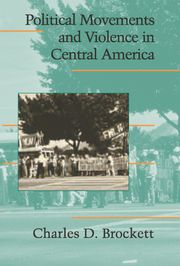Book contents
- Frontmatter
- Contents
- Figures, Tables, and Maps
- Abbreviations and Acronyms
- Acknowledgments
- 1 INTRODUCTION
- Part One From Grievances to Contentious Movements
- Part Two Opportunity, Contention, and Repression
- 6 CYCLES OF CONTENTION
- 7 CHANGING POLITICAL OPPORTUNITIES AND CONTENTIOUS CHALLENGERS: GUATEMALA
- 8 CHANGING POLITICAL OPPORTUNITIES AND CONTENTIOUS CHALLENGERS: EL SALVADOR AND CENTRAL AMERICA
- 9 CONTENTION AND REPRESSION: GUATEMALA
- 10 CONTENTION AND REPRESSION: EL SALVADOR
- 11 CONCLUSION
- References
- Index
8 - CHANGING POLITICAL OPPORTUNITIES AND CONTENTIOUS CHALLENGERS: EL SALVADOR AND CENTRAL AMERICA
Published online by Cambridge University Press: 23 November 2009
- Frontmatter
- Contents
- Figures, Tables, and Maps
- Abbreviations and Acronyms
- Acknowledgments
- 1 INTRODUCTION
- Part One From Grievances to Contentious Movements
- Part Two Opportunity, Contention, and Repression
- 6 CYCLES OF CONTENTION
- 7 CHANGING POLITICAL OPPORTUNITIES AND CONTENTIOUS CHALLENGERS: GUATEMALA
- 8 CHANGING POLITICAL OPPORTUNITIES AND CONTENTIOUS CHALLENGERS: EL SALVADOR AND CENTRAL AMERICA
- 9 CONTENTION AND REPRESSION: GUATEMALA
- 10 CONTENTION AND REPRESSION: EL SALVADOR
- 11 CONCLUSION
- References
- Index
Summary
Contentious movements reached high levels of activity in El Salvador in a democratic opening in the early 1930s and again in 1944 when popular forces brought down a long-governing dictator. Otherwise, political space was too limited for any effective organizing into the 1960s, with only brief exceptions. Consequently, activists in El Salvador in the 1960s and 1970s were attempting to mobilize a population with limited experience in contentious politics, certainly compared to their Guatemalan counterparts who instead were struggling to energize remobilization following the 1954 overthrow of Arbenz and the repression that it brought.
Progressive activists succeeded in mounting three different contentious campaigns in El Salvador during the three decades after 1960. The first led up to the election of February 1972. The second, and far more intense protest cycle, led into the civil war that began in 1980. The third is as astonishing as its counterpart in Guatemala – the resumption in the mid-1980s of a nonviolent protest movement in the capital once state violence directed at movement activists declined sufficiently, yet occurring in the midst of a continuing civil war. Heightened grievances were important to each of these campaigns as was the mobilization of organizational resources, as detailed in prior chapters. Critical too was the opening of greater political opportunities. Although each dimension of the configuration of political opportunities usually played a role in facilitating movement emergence, their rise and fall was often tied to corresponding fluctuations in the use of violence by the state against social movement activists.
- Type
- Chapter
- Information
- Political Movements and Violence in Central America , pp. 230 - 264Publisher: Cambridge University PressPrint publication year: 2005

